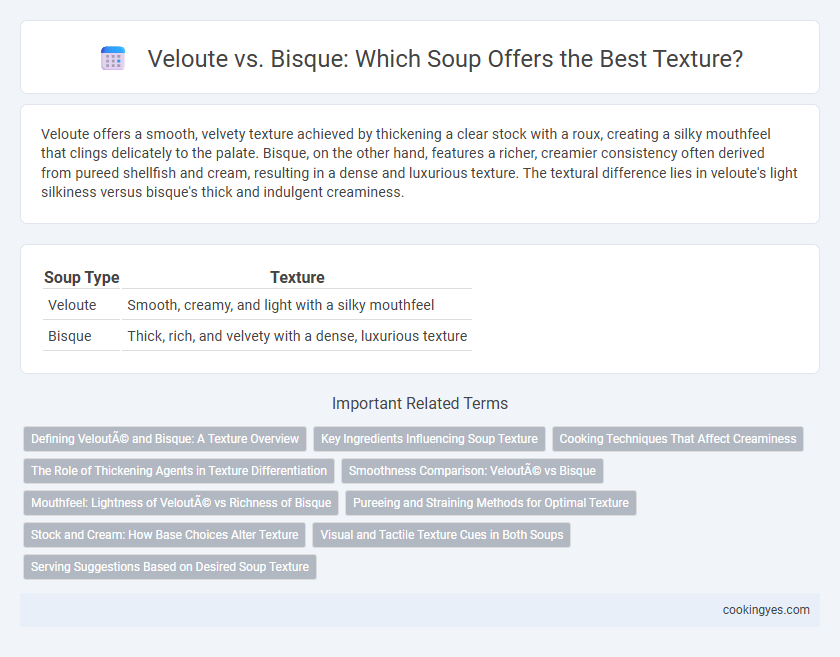Veloute offers a smooth, velvety texture achieved by thickening a clear stock with a roux, creating a silky mouthfeel that clings delicately to the palate. Bisque, on the other hand, features a richer, creamier consistency often derived from pureed shellfish and cream, resulting in a dense and luxurious texture. The textural difference lies in veloute's light silkiness versus bisque's thick and indulgent creaminess.
Table of Comparison
| Soup Type | Texture |
|---|---|
| Veloute | Smooth, creamy, and light with a silky mouthfeel |
| Bisque | Thick, rich, and velvety with a dense, luxurious texture |
Defining Velouté and Bisque: A Texture Overview
Veloute soup offers a smooth, velvety texture achieved by thickening clear stock with a light roux, resulting in a delicate mouthfeel that is both creamy and refined. Bisque, on the other hand, is characterized by a rich, silky texture derived from pureed shellfish or vegetables combined with cream and often strained for ultimate smoothness. The key textural difference lies in veloute's subtle silkiness versus bisque's dense, luxurious consistency that highlights its intense flavor profile.
Key Ingredients Influencing Soup Texture
Veloute soup features a smooth, velvety texture primarily achieved through a roux base made from butter and flour combined with light stock, which thickens the soup without heaviness. Bisque relies on pureed shellfish, cream, and a thickened broth, producing a rich, creamy texture enhanced by the natural gelatin released from crustacean shells during simmering. The key ingredients influencing texture in veloute are the roux and stock, while bisque's texture depends on shellfish puree, cream, and the extracted gelatin.
Cooking Techniques That Affect Creaminess
Veloute achieves its smooth, creamy texture through the careful use of a blond roux combined with clear stock, whisked continuously to avoid lumps and ensure a velvety consistency. Bisque relies on slow simmering of shellfish shells for rich flavor extraction, followed by pureeing and heavy cream incorporation to create its distinct, silky texture. The key difference lies in veloute's emphasis on roux-based thickening versus bisque's reduction and blending processes, which directly impact their respective creaminess levels.
The Role of Thickening Agents in Texture Differentiation
Veloute soup achieves its smooth, velvety texture primarily through a roux-based thickening agent made from butter and flour, creating a creamy mouthfeel without graininess. Bisque relies on a combination of rice or cream to thicken, resulting in a rich, silky texture often complemented by pureed shellfish or vegetables for added body. The choice of thickening agent directly influences the final texture, with roux providing a subtle creaminess in veloute and bisque's starch or dairy components delivering a denser, more luxurious consistency.
Smoothness Comparison: Velouté vs Bisque
Veloute soup is characterized by its exceptionally smooth and creamy texture, achieved through a velvety blend of stock, roux, and cream that provides a consistent mouthfeel. Bisque, while also smooth, has a richer, slightly thicker texture due to the inclusion of pureed shellfish or vegetables, offering a more intense flavor profile with a delicate graininess. The smoothness of veloute is more uniform and silky, whereas bisque delivers a hearty yet refined consistency highlighting its detailed ingredient base.
Mouthfeel: Lightness of Velouté vs Richness of Bisque
Veloute soup offers a smooth, velvety mouthfeel characterized by its lightness and delicate texture, often achieved through a combination of stock, roux, and cream. In contrast, bisque delivers a richer, thicker texture with a luxurious, creamy mouthfeel, typically made from shellfish and heavy cream, providing a more opulent experience. The lightness of veloute makes it ideal for a subtle, refined palate, while bisque's richness caters to those seeking a bolder, more indulgent soup.
Pureeing and Straining Methods for Optimal Texture
Veloute soup achieves a smooth, velvety texture through careful pureeing and fine straining, often using a blender followed by a chinois or fine-mesh sieve to remove any solids. Bisque relies on pureeing cooked shellfish shells and vegetables, then passing the mixture through a fine sieve to create a rich, creamy texture without graininess. Proper straining techniques in both soups eliminate fibrous or chunky bits, ensuring a silky mouthfeel essential to their classic profiles.
Stock and Cream: How Base Choices Alter Texture
Veloute soup relies on a light, clear stock such as chicken or fish, thickened with a roux to create a smooth, velvety texture without heaviness. Bisque uses rich shellfish stock combined with heavy cream or butter, resulting in a thicker, creamier mouthfeel that enhances its luxurious, silky consistency. The choice of base--clear stock with roux versus shellfish stock with cream--directly defines the soup's texture, balancing between light refinement and rich indulgence.
Visual and Tactile Texture Cues in Both Soups
Veloute soup features a smooth, creamy texture with a velvety mouthfeel evident in its pale, uniform surface, offering a visually consistent and tactilely soft experience. Bisque presents a thicker, slightly grainier texture with a rich, glossy appearance, often retaining small bits of shellfish or vegetables that provide a subtly coarse tactile contrast. The visual cues in veloute's silky sheen signal a refined smoothness, whereas bisque's textured surface invites anticipation of a more robust, hearty bite.
Serving Suggestions Based on Desired Soup Texture
Veloute soups feature a smooth, creamy texture achieved by thickening light stock with a roux, making them ideal for elegant presentations and pairing with delicate garnishes like julienned vegetables or fresh herbs. Bisques offer a richer, velvety texture created from pureed shellfish or vegetables combined with cream, best served hot with a dollop of creme fraiche or a sprinkle of paprika to enhance their luxurious mouthfeel. Choose veloute for lighter texture preferences and bisque when desiring a more intense, creamy consistency in serving.
Velouté vs Bisque for Texture Infographic

 cookingyes.com
cookingyes.com